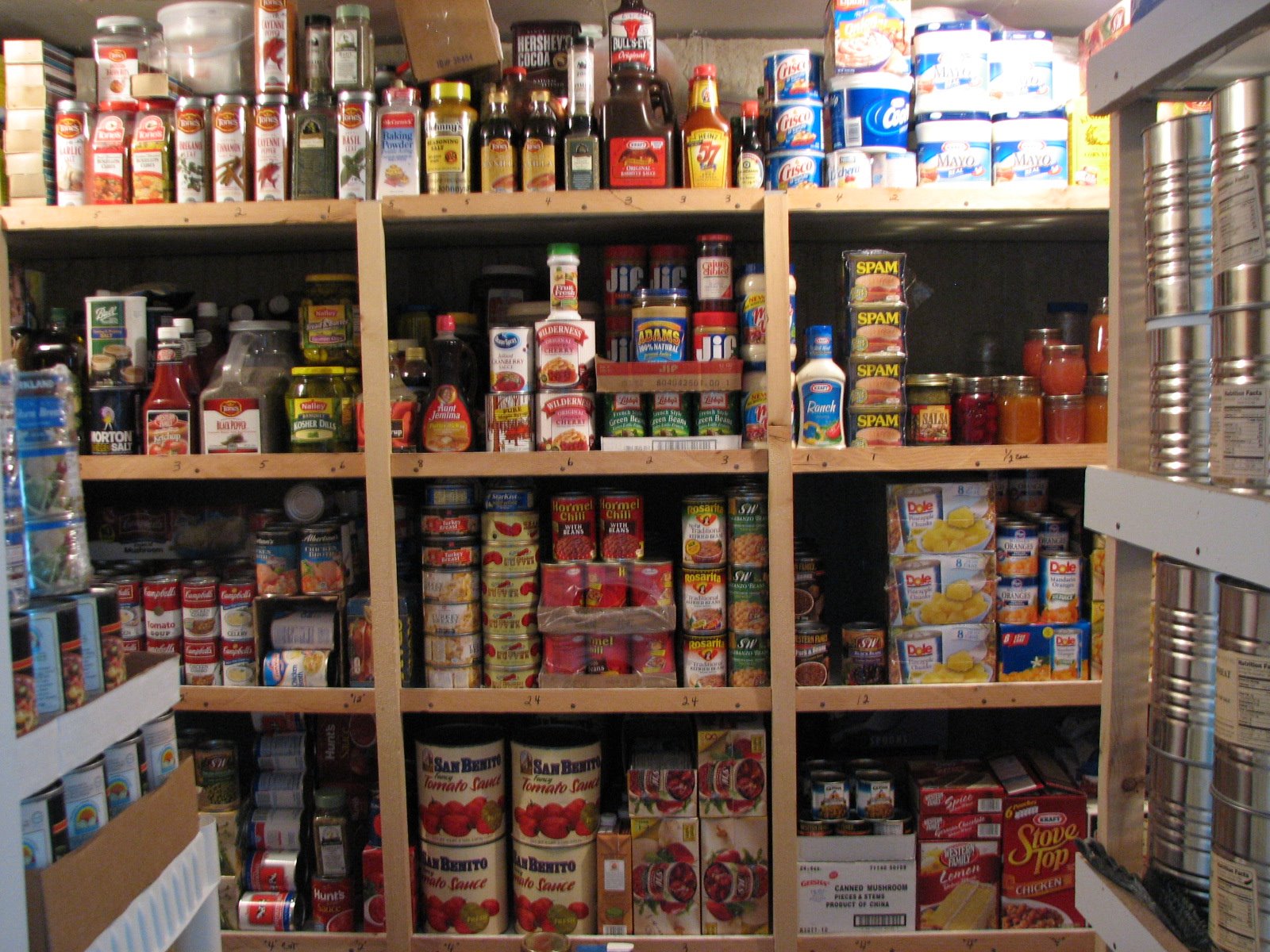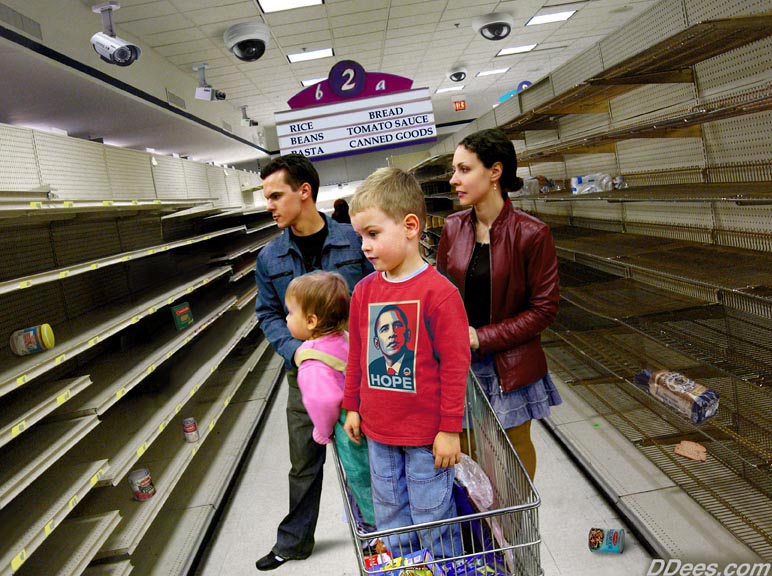The most important reason to store food is that it comes in very handy in a crisis. It is comforting to know that you can use your home grocery store for an emergency and to help buffer lean money times. If you had to live on what you had in your basement for an extended period of time, you would wish you had a well-rounded supply of food.
In general, most households do not have more than a one-week supply of food. As a nation, we rely almost totally on the supermarket and fast food restaurants. According to the U.S. Department of Agriculture, the cost of feeding a family of four at home in July ranged from $568 per month (thrifty plan) to $1,293.20 per month (liberal plan). Wow! With food prices rising, your best investment right now is food.
If you ask any supermarket chain manager to tell you how long it would take to empty the shelves in any store in the event of a crises, the answer would be about three days. People storm grocery stores and buy anything they could get. The water is the first thing that goes.
I strongly suggest that you find a place in your home - either in a basement, spare bedroom, closet, junk room, under the stairway or in a heated garage - and go to work turning it into your own home grocery store and pharmacy. Somehow, get shelves in there. Build them, have them built or buy them pre-built, whatever works best for you. Just do it now.
This home grocery store will be to you and your family as the ark was to Noah and his family. It will contain all the necessary food, water, bedding and medical supplies to sustain life for a minimum of three months to one year.
What are the best kinds of food to stockpile? It is recommended that you "store what you eat and eat what you store." Otherwise, you might get sick. A crisis is not the time to change your family's diet.
Appetite fatigue is a very serious condition. Food storage experiments have been conducted wherein people had mock disasters and lived on their basic food storage for extended periods of time.
If you are suddenly thrown into a diet that you are not used to - especially one with a lot of wheat, beans, corn, honey, powdered milk and dehydrated food - you will have a double crisis. One thing people do not need in an emergency is sickness caused by a drastic change in diet.
It is best to incorporate dehydrated foods into your diet gradually. These are the foods that store well for the long term. To rehydrate them, you just need to add water, so they are good to have in your storage, along with any canned goods that you like. The shelf life on canned goods is about two years and on dehydrated food up to 10 years.
There is nothing wrong with storing wheat, beans, rice, powdered milk and honey, if that is what you are used to and prefer. Store a variety of wheat and other grains, along with flour, oatmeal, rice, noodles, evaporated milk, beans, peas, lentils, legumes, canned meats, tuna fish, canned salmon, soup of all kinds, tomatoes, sauces of all kinds, all baking items, shortening, oils, peanut butter, jams, syrups, salad dressings, mayonnaise, Jell-O, cocoa, bottled fruits and vegetables and many other dehydrated products.
Comment: Most of the food items mentioned above contain high amounts of carbs and all kinds of things that are not health-promoting. Something to consider is storing food for a ketogenic diet, which if you can get on prior to a crises, will put you in a much better position to keep you healthy against Ebola, and other life-threatening illnesses that are coming down the pike. What food you decide to store is just as important, if not more so, than the choice to store food at all.
See also:
Nothing should be kept for more than two years without rotating except the following: wheat, grains, beans, sugar, salt and any product that is nitrogen-packed for long-term storage and has a low oxygen content.
If people store what they eat and eat what they store, the rotation will automatically take care of itself. Rotating your food so your family gets accustomed to eating the grains, beans, honey and dehydrated products is very important.
Always replace each item as it is used up so you can maintain your stockpile. Purchase cases of items when they come on sale. Our hometown grocery store has case lot sales about four times a year. The best prices are when items are in season. I buy wet-pack corn and beans in the fall when they are two cans for $1. When tuna is on sale, I buy three or four cases. It's an excellent source of protein, and I save a lot of money by purchasing in bulk.
A sample formula for knowing how much food to store is to keep track of what you eat for a two-week period of time. Surprisingly, most families repeat meals every few days. Multiply the basic ingredients by six to calculate a three-month supply, 13 for a six-month supply and 26 to calculate a year's supply. Separate menus can be calculated for summer and winter taking into consideration gardening and seasonal foods available. Build your own stockpile slowly, over a six-month period of time.
A hint that has helped me to obtain extra food items: Every time I go to the grocery store I get two of each item that I normally buy, such as ketchup, barbecue sauce, pickles, olives, cream soups, mayonnaise, salad dressing, spaghetti sauces, mixes, etc. I put one away and use the other. It's a good idea to keep adding more and more of a variety of items to your home grocery store, so your diet won't be so bland.
Planned menus can eliminate the panicked feeling you get when you know you should store food and you don't know where to begin.
If you plan your food storage program carefully, you can avoid impulse or panic buying, which will save you a lot of money and grief. Anticipate your needs for a three-month period of time. Buy bulk food in larger quantities and store them in plastic food-grade buckets that have airtight lids. Do not use paint buckets or any other container that has been used for chemicals. Do not use garbage bags, as they are treated with pesticides. A food-grade Mylar liner inside a plastic bucket works very well with an oxygen absorber vacuum packed and sealed.
Store your food in a cool, dry place away from sunlight and in a place that stays a constant temperature of around 40-60 degrees Fahrenheit. Hot or cold fluctuations in temperatures can destroy the nutritive value of the food and shorten its shelf life. A basement or cold storage area is ideal.
Always label every can, bottle or bucket with what is in each container, the date of purchase, shelf life, and the date to be used by.
A three-month, well-rounded supply of food storage is much better than a year's supply of wheat, beans, honey and powdered milk. The basics are important, but it is just the beginning.
This information came from my books "Food Storage 101. Where do I begin?" and "Emergency Food Storage and Survival Handbook."





Thank-you for reminding me. As I was raking leaves, (I am in a part of The US that burns raked leaves) I thought about how once it snows and if a fire needs to be started for cooking warmth etc, leaves and the twigs among them become so very important. But if one waits till then what then? Try and dig through the snow for wet frozen leaves and twigs? So I gathered a ggod amount of the above mentioned and put them in several bags.
But food? I have enough for say, 3 to 4 days.
So again, thank-you for reminding me.
May Peace and Happiness, Health and Love be with all of my Brothers and Sisters Throughout the World.